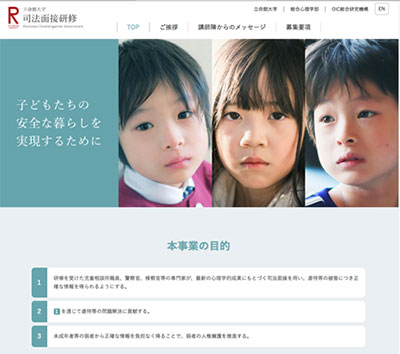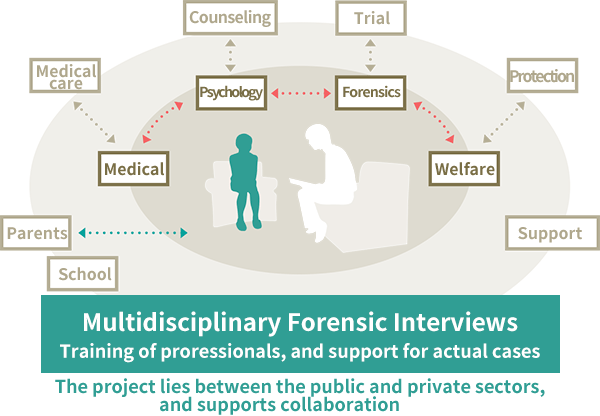Research Results
Training program for multi-disciplinary investigative interviews
Training for and implementing collaborative investigative interviews for child protection and welfareFY2021

- Naka Makiko (Professor,Research Organization of Open Innovation and Collaboration, Ritsumeikan University/Emeritus Professor,Hokkaido University)
- RISTEX R&D program "Protecting children from crime"
- Training Program for Video Recorded Interview with Children in Forensic Contest (2008-2012)
- RISTEX R&D program "Creating a safe and secure living environment in the changing public and private spheres"
- Development and Provision of a Training Program to Foster the Use of Forensic Interviews by Multidisciplinary Team (2015-2019)
Development and implementation of a training program for forensic interviews
" Creating a Safe and Secure Living Environment in the Changing Public and Private Spheres " (2015-2019)
Professor Naka Makiko and her R&D team organized a training program to support "collaborative interviews" in which multiple agencies such as child guidance centers, law enforcement, and prosecutors collaborate to conduct forensic interviews. They also organized a program to train trainers. So far they have trained more than 10,000 professionals on forensic interviews and trained more than 100 trainers.
They also provided the support for actual forensic interviews and multi-institutional collaboration, and the forensic interview method based on the NICHD protocol taught by Professor Naka and her team is now being used in the field of welfare and forensic procedures.
Further, for effective interviews through interpreters and/or with intermediaries, and for multi-institutional collaboration including mental and physical care for children with trauma, Professor Habuchi Yoshiko and Associate Professor Tanaka Akiko of the team developed a network of professionals to promote a multi-disciplinary approach to help children in need.
In 2020 Ritsumeikan University decided to support this training program, and began providing continuous multi-institutional collaborative training programs to professionals. A RISTEX follow-up program, "Support for delivering R&D outcomes to society" was used for the launch of this activity.

Fig. 1 Website for forensic interview training by Ritsumeikan University
https://www.ritsumei.ac.jp/research/forensic/
Reducing the burden on children through multi-institution collaboration
There has been a nationwide increase in the effort to detect and deal with child abuse. Accordingly, professionals in the field are attempting to elicit sufficient and accurate information from alleged abuse victims. However, as children are still developing cognitive abilities in memory and communication, it is not always easy for them to provide reliable information.
In response to this situation, Professor Naka and her team developed "Training Program for Video Recorded Interviews with Children in Forensic Context" (2008-2012). It included a forensic interview method suitable for the Japanese context based on the NICHD protocol, a world-wide investigative interviewing method, and an associated training program. They also organized training for social workers, and measured its effectiveness.
Through the dissemination of interview methods and training programs, new challenges were discovered. In addition to welfare intervention, it became clear that forensic and medical intervention is often required in the event of abuse. A child’s capacity for recollection is likely to deteriorate over time and successive interviews, which may increase the risk of obtaining inaccurate information. Moreover, bad memories are revived at each interview, which may exacerbate secondary psychological damage.
In order to avoid these problems and listen to the voices of victims accurately without giving them further stress, many specialized agencies need to work together to reduce the number of forensic interviews. Therefore, in the project "Training program for Development and Implementation of Forensic Interviews through Multidisciplinary Collaboration" (2015-2019), Professor Naka and her team designed collaborative interview methods to be implemented by multiple institutions, set up a training program to train professionals on the method, and developed a program to train trainers as well.

Fig. 2 Schematic diagram of multidisciplinary forensic interviews
Training more than 10,000 professionals, and training the trainers
The training program was developed to promote multidisciplinary collaboration based on the results of "Training Program for Video Recorded Interview with Children in Forensic Context " (2008-2012) and related JSPS research outcomes. The feature of this program is that social workers, police and prosecutors can form a team, learn about forensic interviews, and conduct role play interviews, while discussing and cooperating. In cases of abuse, differences in the goals and positions of welfare and forensic institutions can make cooperation difficult. In order to overcome the gaps, this program is designed to strengthen cooperation while focusing on fact-finding.
Professor Naka and her team have offered forensic interview training for more than 10,000 professionals (social workers, police, prosecutors, medical institutions, psychologists, welfare facility staff, etc.). After the training, the amount of open-ended questions (questions that can elicit free narratives instead of yes/no), the amount of words spoken by the interviewees, and the ratio of accurate information increased compared to before the training.
They then established a training program to train professionals to become trainers who can provide training by themselves. They have trained more than 100 trainers so far.
As for basic research, in addition to the studies on the effect of interview method and professionals’ perception of multi-institutional collaboration by Professor Naka, Professor Habuchi and Associate Professor Tanaka clarified the problem of forensic interviews that incorporate interpreters and intermediaries for foreigners, designed guidelines and training programs, and developed easy Japanese language witness follow-up surveys. They also promoted the links between forensic interviews and clinical care through training and workshops.

Fig. 3 Collaborative multidisciplinary interviews
Further expansion and development in consideration of victims
Currently, collaborative interviews by child guidance centers, police and prosecutors are becoming widespread. If the importance of such a method can be recognized by medical institutions, schools and other facilities, and clinical psychologists and medical staff are involved in the forensic interviews, the accuracy of information will be further increased and victims’ psychological stress will be lessened. We hope that the forensic interview training by Ritsumeikan University will help popularize the cooperative interview method, and help better protect those children under stress.
